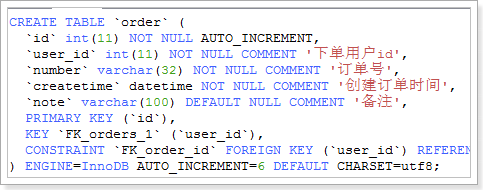mybatis中resultType可以指定将查询结果映射为pojo,但需要pojo的属性名和sql查询的列名一致方可映射成功。如果sql查询字段名和pojo的属性名不一致,可以通过resultMap将字段名和属性名作一个对应关系 ,resultMap实质上还需要将查询结果映射到pojo对象中。resultMap可以实现将查询结果映射为复杂类型的pojo,比如在查询结果映射对象中包括pojo和list实现一对一查询和一对多查询。
需求:查询订单表order的所有数据
sql:SELECT id, user_id, number, createtime, note FROM `order`
声明pojo对象
数据库表如下图:

Order对象:
public class Order {
// 订单id
private int id;
// 用户id
private Integer userId;
// 订单号
private String number;
// 订单创建时间
private Date createtime;
// 备注
private String note;
get/set。。。
}
Mapper.xml文件
创建OrderMapper.xml配置文件,如下:
<?xml version="1.0" encoding="UTF-8" ?>
<!DOCTYPE mapper
PUBLIC "-//mybatis.org//DTD Mapper 3.0//EN"
"http://mybatis.org/dtd/mybatis-3-mapper.dtd">
<!-- namespace:命名空间,用于隔离sql,还有一个很重要的作用,Mapper动态代理开发的时候使用,需要指定Mapper的类路径 -->
<mapper namespace="cn.itcast.mybatis.mapper.OrderMapper">
<!-- resultMap最终还是要将结果映射到pojo上,type就是指定映射到哪一个pojo -->
<!-- id:设置ResultMap的id -->
<resultMap type="order" id="orderResultMap">
<!-- 定义主键 ,非常重要。如果是多个字段,则定义多个id -->
<!-- property:主键在pojo中的属性名 -->
<!-- column:主键在数据库中的列名 -->
<id property="id" column="id" />
<!-- 定义普通属性 -->
<result property="userId" column="user_id" />
<result property="number" column="number" />
<result property="createtime" column="createtime" />
<result property="note" column="note" />
</resultMap>
<!-- 查询所有的订单数据 -->
<select id="queryOrderAll" resultMap="orderResultMap">
SELECT id, user_id,number,createtime, note FROM `order`
</select>
</mapper>
测试方法
编写测试方法OrderMapperTest如下:
public class OrderMapperTest {
private SqlSessionFactory sqlSessionFactory;
@Before
public void init() throws Exception {
InputStream inputStream = Resources.getResourceAsStream("SqlMapConfig.xml");
this.sqlSessionFactory = new SqlSessionFactoryBuilder().build(inputStream);
}
@Test
public void testQueryAll() {
// 获取sqlSession
SqlSession sqlSession = this.sqlSessionFactory.openSession();
// 获取OrderMapper
OrderMapper orderMapper = sqlSession.getMapper(OrderMapper.class);
// 执行查询
List<Order> list = orderMapper.queryOrderAll();
for (Order order : list) {
System.out.println(order);
}}}
